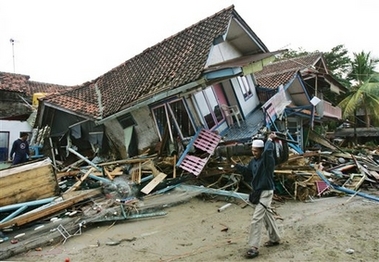Within minutes of the earthquake, regional tsunami centers warned it had the
potential to send a deadly wave speeding toward Indonesia. But the country had
no way of passing the information onto those in its path until it was too late.
Indonesia was the worst hit by the 2004 tsunami, and Monday's disaster shows
how unprepared the sprawling island nation remains in dealing with the threat of
tsunami triggered by the awesome seismic forces that lie beneath it.
|

An Indonesian man
carries his belongings as he walks past by a destroyed house at a
tsunami-ravaged area in Pangandaran, West Java, Indonesia, Tuesday, July
18, 2006. Desperate villagers and soldiers dug through destroyed homes and
hotels looking for survivors Tuesday of a tsunami on Indonesia's Java
island, as the death toll rose to at least 262, officials and media
reports said. [AP]
|
Most people at this devastated beach resort did not feel the 7.7-magnitude
earthquake and few noticed the ocean receding - a typical phenomenon before
a tsunami - because the tide was already low and the effect was not
especially pronounced, local residents and tourists said Tuesday.
"The police and local officials did not give us any warning whatsoever about
the tsunami," said Supratu, a fisherman. "Suddenly this big wall of water
appeared and I started screaming and running."
The earthquake struck at 3:19 p.m., and the Pacific Tsunami Warning Center
issued an alert 17 minutes later saying a tsunami was possible. The first of
several waves hit Java's southern coast at around 4:15 p.m. - nearly an
hour after the temblor, witnesses said.
Indonesia initially registered the quake at under magnitude 6, and by the
time government scientists realized its true power it was too late to warn
government offices across the danger zone, said scientist Fauzi, who goes by
only one name.
We tried to radio them "but there was no way we had the time," he said.
But even if they'd succeeded, without an automated system in place to pass
the message on to villagers via loudspeakers on beaches or mobile phone text
messages, the evacuation of significant numbers of people would have been
unlikely.
The tsunami killed at least 339 people and destroyed hundreds of homes.
With international help, Indonesia has begun installing a tsunami warning
system off Aceh province on Sumatra island, where more than 130,000 of the some
216,000 victims of the 2004 tsunami lived. It plans to roll out the system
across the country of 18,000 islands by 2009, officials said Tuesday.